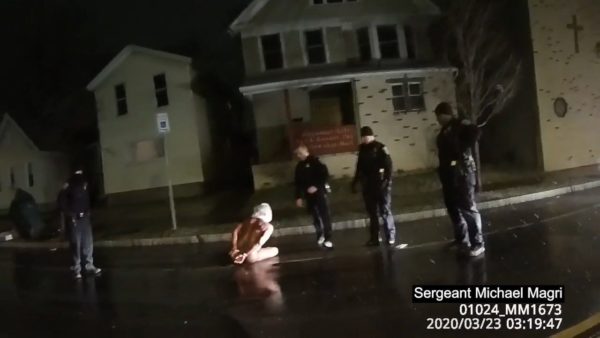The syndrome excited delirium has been often used to increase force against people in police custody and justify their deaths, but a new study by Harvard doctors has outed it for its racist roots, its lack of scientific basis and its disproportionate use against Black people.
A Berkeley Law professor found out of 166 people reported having died from excited delirium from 2010 to 2020, 43.3 percent were Black. It has been referenced by medical examiners in the deaths of George Floyd, Daniel Prude, Elijah McClain and Manuel Ellis.

The new study published by the Physicians for Human Rights found that the syndrome, based on racist origins, is “bogus” and being used to justify the police killings of Black people.
“The term ‘excited delirium’ cannot be disentangled from its racist and unscientific origins,” researchers said.
Daniel Prude was arrested amid a mental health crisis in 2020 when officers pinned him to the ground and pressed their weight on his head, back and legs with a spit hood on his face. Donald Thompson, a lawyer for Prude’s family, said one of the ambulance personnel responding to the scene blamed excited delirium for Prude’s condition.
“Oh, don’t worry. This is excited delirium. It’s nothing that you guys did. Don’t be concerned about it,” Thompson recalled the first responder saying on the body-worn camera. “That’s even while he’s being restrained and well before he stops breathing before he’s deceased. So, it’s like the knee-jerk reaction of anyone responding in a law enforcement context.”

Excited delirium is defined in the Western Journal of Emergency Medicine as “agitation, aggression, acute distress and sudden death,” typically associated with drug use and, “most notably, sometimes with death of the affected person in the custody of law enforcement.”
However, Physicians for Human Rights researchers say there is no consensus on the meaning, which is “problematic in itself.” It is not included in the World Health Organization’s International Classification of Diseases or the Diagnostic and Statistical Manual of Mental Disorders.
It’s also not recognized by the American Medical Association or the American Psychiatric Association, but that has not stopped the syndrome from being widely used by first responders and medical examiners.
Law enforcement officers are trained to look for “superhuman strength” and people who are showing “imperviousness to pain,” triggering the need for more force, according to research.
Physicians for Human Rights contends that excited delirium is a series of symptoms or signs of other underlying conditions and not a medical diagnosis. Coroners and medical examiners should not cite it as a cause of death, the researchers said.
The symptoms can include confusion, fear, hyperactivity, acute psychosis, sweats, noncompliance with directions, rapid heart rate and rapid breathing. Those same symptoms can be linked to cocaine use, methamphetamines, alcohol intoxication, infection and mental illness, said Dr. Altaf Saadi, one of the study’s authors.
“So you can see what a convenient diagnosis this can be that law enforcement can use it to describe virtually anyone with a wide variety of underlying conditions,” Saadi, a neurologist and Harvard professor, said.
Law enforcement officials said that officers are trained to restrain people with excited delirium for their safety. However, Saadi said medically trained professionals should be the first point of contact or make decisions when a person is experiencing a medical or mental health crisis.

“There were a lot of people who had underlying conditions that could be treated medically,” Saadi said. “But because of the use of this diagnosis, we’re being neglected or being restrained or beaten or choked.”
The group of physicians also recommend an uniform process to establish causes of death, replacing coroner systems with medical examiners who are board certified forensic pathologists and keeping the medical examiner’s office independent from law enforcement agencies to avoid conflict.
Drs. Charles Wetli and David Fishbain first coined the term in 1981 in reference to a person who had died from swallowing cocaine. They revived the term in 1985 case reports on cocaine intoxication, where people were restrained and died of respiratory arrest. Five were in police custody.
Wetli also used the theory to explain the death of a dozen Black women in Miami, presumed sex workers, who died with traces of cocaine in their systems. He concluded that cocaine mixed with a blood type most common among Black people is “lethal.”
“For some reason, the male of the species becomes psychotic, and the female of the species dies in relation to sex,” he stated.
Wetli’s theory was later debunked when a 14-year-old was killed in a similar situation without cocaine in her system. Wetli’s supervisor found that the women had been strangled by a serial killer who murdered 32 women from 1980 to 1989. Still, Wetli continued to promote the theory and argued that some of the women had to have died from sex and cocaine because they were too “streetwise” to have fallen victim to a serial killer.
A group of researchers for Axon Enterprise, the company behind the taser, and legal defense experts for law enforcement agencies then picked up the theory.
According to the study, key researchers wrote a book about excited delirium and distributed it for free. They also gave handouts to medical examiners and police chiefs at industry conferences.
A 2009 American College of Emergency Physicians white paper and two studies by the National Association of Medical Examiners on excited delirium have been cited in several court cases, the study shows.
Researcher Joanna Naples-Mitchell said they would like both organizations to issue official statements refuting their studies.
“As long as there are others who are saying this is a real term, they’ve allowed expert witnesses to testify about it in court as if there’s no challenge to the use of this term in the medical profession,” said Naples-Mitchell. “So that’s really disturbing.”
Since the Physicians for Human Rights published the study on March 2, both the American College of Emergency Physicians and the National Association of Medical Examiners said it never officially endorsed the term and just showcased the authors’ work.
The medical examiners’ association president, Dr. Kathryn Pinneri, told CNN, however, she suspected it is accepted among members.
Robert Collins’ stepson Angelo Quinto was also killed in police custody while experiencing a mental health emergency. He said he hopes the findings in the study will expose the medical illegitimacy of excited delirium. Quinto’s death was also linked to excited delirium by authorities.
Still, he fears the term could just be swapped out for another term used to “cover-up” more in-custody deaths.
The American College of Emergency Physicians published a new paper in 2021 reframing the concept as hyperactive delirium or severe agitation.
When police arrived at their home in December 2020, they took Quinto from his mother’s arms onto the floor where they knelt on his neck for five minutes. His mother, Cassandra Quinto-Collins, said she asked the officers to check on his vitals multiple times, but they ignored her. He died at the hospital three days later.
“Changing the name doesn’t change what makes it so wrong, which is that it’s being used to cover up police misdeeds,” Collins said.


